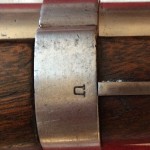- Colt Model 1861 Rifle Musket, Ramrod, Socket Bayonet
- Colt Model 1861 Rifle Musket, Shoulder Stock
- Colt Rifle Musket, Forward Stock & Barrel
- Colt Rifle Musket Lock Plate
- Colt’s Patent FireArms Manufacturing’s Company, Hartford Connecticut
- Colt Model 1861 Viewed & Proof Stamps
- Colt Rifle Musket Front Sight & Nose Cap
- Colt Musket, New Jersey Contract Musket
- Collins & Company Socket Bayonet
- Colt Model 1861 Special Rifle Musket, New Jersey Markings
Colt Model 1861 Special Musket was Manufactured between 1861-1865 with production estimated between 75,000 & 100,000. Originally made for the Federal Government to support the war effort, however many failed the stringent government inspections yet were definitely serviceable. Classified by Colt as “Second Class U.S. Rifle Muskets” many were sold to Northern states to support local Militias. New York outfitters and arms dealer Schuyler, Hartley & Graham sold 2,500 of these muskets to the state of Connecticut in July of 1863. But it seems most were sold to the state of New Jersey based on surviving examples.
Quick identification of the Colt Second Class musket is the “N.J.” on the left side of the barrel and left stock flat opposite the lock plate however the usual Ordnance Department proof (cartouche) or final inspection markings are absent.
58 caliber single shot muzzle loader made with 40” barrels and three barrel bands. Oil stained walnut stock with most metal parts finished “in the white” but bluing was standard on rear sight, nipples, and various screws. The Colt musket has no serial number.
My new Colt rifle musket is dated 1862 on the lock plate and 1863 on the barrel flat. It’s in extremely good condition however at sometime someone has sanded the stock and polished the barrel, fortunately by hand and not an electric buffer.
Included with the musket is a Collins & Co. socket bayonet which would be correct for a Colt musket rifle. All in all this is a pretty nice example of a surviving Union made Rifle Musket.
Thanks for stopping by and looking at my virtual museum. I have many new items that I will be adding shortly, in the meantime if you have any questions about this post feel free to contact me at civilwararsenal@yahoo.com attn: Gene West.





































